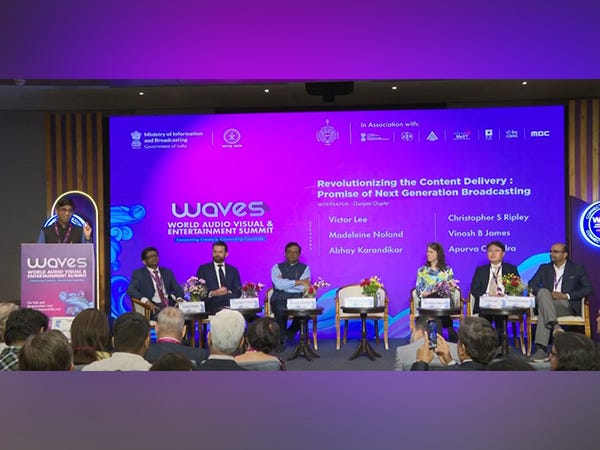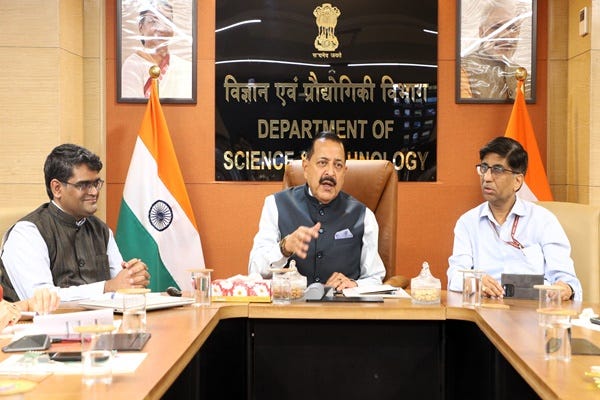Signal to Scale: India’s D2M Chip, AI Safety, and the Self-Reliant Stack
The AI4India Weekly #51
At the crossroads of broadcasting and AI, India is making bold moves toward digital self-reliance. The WAVE Summit 2025 saw the launch of the nation’s first indigenous semiconductor chip for Direct-to-Mobile (D2M) broadcasting—an innovation that can beam video, audio, and data directly to mobile phones, even without internet. This leap, developed by Saankhya Labs with IIT Kanpur and Prasar Bharati, exemplifies how India’s public-private-academic partnerships are powering the next generation of communication and service delivery.
Meanwhile, the government continues to deepen its commitment to an IndiaAI stack, AI safety standards, and nationwide skilling programs—with collaborations like Intel + MeitY aiming to scale talent pipelines, and the ANRF guiding future research directions. Also in this edition: a sharp commentary on why GenAI must evolve from output to true transformation—and a cautionary note on the growing glut of meaningless AI content online.
India’s First Semiconductor Chip for D2M: A Leap Toward Next-Gen Broadcasting
At the recently concluded WAVE Summit 2025 in New Delhi, India marked a major milestone in its journey toward digital self-reliance with the unveiling of the country’s first indigenously developed semiconductor chip for Direct-to-Mobile (D2M) broadcasting. Developed by Saankhya Labs, a subsidiary of Tejas Networks, this breakthrough chip enables broadcast of video, audio, and data content directly to mobile phones—without the need for internet or data consumption.
The chip was launched in collaboration with Prasar Bharati and IIT Kanpur, underlining the strength of public-private-academic partnerships in advancing India’s tech ecosystem. By enabling simultaneous broadcast to millions of devices, D2M has the potential to revolutionize public service delivery—offering cost-effective, resilient, and real-time access to emergency alerts, educational programming, and government messaging, even in areas with patchy or no internet connectivity.
The announcement was one of the highlights of WAVE 2025 (Wireless, AI, Video, Edge)—a summit focused on the convergence of emerging technologies like AI, 5G, and edge computing in the broadcasting and telecom sectors. The event brought together policymakers, researchers, startups, and industry leaders to shape the roadmap for next-generation digital infrastructure in India.
Shashi Shekhar Vempati, Co-Founder of Bharat4India Foundation (AI4India), welcomed the development, noting:
“This innovation reflects India’s unique approach to integrating AI, semiconductors, and digital infrastructure for inclusive growth. D2M has the potential to redefine how content reaches citizens—efficiently, affordably, and at scale.”
Building India's Indigenous AI Stack: A Vision for Self-Reliant Innovation
Union Minister of State for Science and Technology, Dr. Jitendra Singh, has emphasized the imperative of developing an indigenous India AI Open Stack—a foundational AI architecture tailored to the nation's unique scientific and engineering needs. During a comprehensive review of the Department of Science and Technology (DST) in New Delhi, Dr. Singh highlighted the necessity for bold advancements in science-driven growth, including AI-led innovations, deep-tech startups, and enhanced infrastructure sharing.
Central to this vision is the role of the newly constituted Anusandhan National Research Foundation (ANRF). Dr. Singh directed ANRF's CEO, Prof. Abhay Karandikar, to engage with university Vice Chancellors to raise awareness about the foundation's mission and foster collaborative opportunities. Furthermore, he proposed that ANRF assist medical colleges in establishing their own medical research parks, aiming to boost clinical innovation and local biotech entrepreneurship.
This initiative aligns with India's broader strategy to integrate traditional knowledge with cutting-edge technology, as previously emphasized by Dr. Singh. By fostering indigenous capabilities and promoting Atma Nirbharta (self-reliance), India aspires to lead globally in innovation over the next 25 years.
India Accelerates Safe AI Development with National Standards and Manufacturing Push
India is rapidly advancing its leadership in safe and responsible AI by aligning policy, infrastructure, and industry. The government has launched the IndiaAI Safety Institute under the "Safe and Trusted" pillar of the ₹10,000 crore IndiaAI Mission. This institute aims to develop indigenous AI safety frameworks tailored to India's diverse socio-economic landscape, focusing on risk evaluation, ethical deployment, and transparency. Additionally, India is establishing 27 AI and data labs in Tier 2 and Tier 3 cities to democratize access to AI skilling and research infrastructure.
On the international front, India hosted a regional BIMSTEC-ITU workshop in New Delhi to shape responsible AI standards in telecommunications and ICTs. This initiative complements India's commitment to global AI governance, as demonstrated by its chairmanship of the Global Partnership on Artificial Intelligence and hosting of the 2025 International AI Standards Summit. Union Minister Jitin Prasada emphasized India's "AI for All" vision, highlighting the country's leading position in AI skill penetration and talent concentration. These efforts, combined with strategic investments in AI manufacturing and standardization, position India as a key player in shaping the future of safe and inclusive AI.
Intel and IndiaAI Partner to Scale AI Skilling Nationwide
In a strategic move to accelerate AI readiness across the country, Intel has signed a Memorandum of Understanding (MoU) with the IndiaAI initiative of the Ministry of Electronics and IT (MeitY). The collaboration aims to boost AI skilling at scale, particularly by enhancing access to high-quality training resources and expanding digital infrastructure for learners. Through this initiative, Intel will contribute AI curriculum, tools, and expertise to support IndiaAI’s mission of nurturing an inclusive, future-ready AI workforce.
The partnership is aligned with the government’s broader vision to position India as a global AI talent hub. By working together, Intel and MeitY’s IndiaAI platform plan to empower students, educators, and professionals—especially from underserved regions—through localized content and advanced AI labs. As AI becomes increasingly central to India’s development goals, this initiative strengthens the talent pipeline critical for innovation and inclusive digital transformation.
From Better Plans to Better Humans: Why GenAI Must Drive Real Change, Not Just Output
By Adarsh S Lathika
A groundbreaking analysis inspired by Harvard Business Review’s April 2025 article on GenAI usage reveals a critical insight: while AI tools have rapidly evolved to generate personalized outputs—plans, summaries, advice—most fail at translating these into real-world behavioral change. This growing “Transformation Gap” reflects the disconnect between what GenAI delivers and what humans actually do with it. Despite the proliferation of fitness plans, productivity hacks, and self-help templates, a staggering 90% of GenAI’s top self-development use cases still remain output-focused, not outcome-driven. The future of AI won’t belong to those who generate the best content—but to those who enable lasting habit formation, emotional support, and behavioral transformation.
The report dives deep into use case patterns from 2024–2025, highlighting a shift from enterprise productivity to deeply personal applications—therapy bots, emotional coaching, and purpose-finding tools now dominate the top ranks. But success in this new frontier depends on bridging actionability with emotional reinforcement. Tools in the “sweet spot” of both—like AI therapy companions or personalized health coaches—are already showing higher ROI, user retention, and transformation yield. Builders, CXOs, and regulators alike must pivot: stop treating GenAI as a passive assistant and start designing it as an active transformation partner—one that celebrates milestones, adapts to moods, and ultimately, helps people become better versions of themselves.
Buzz of the Week: The Age of AI Slop is Here
The internet is drowning in AI slop—bland, autogenerated content clogging social media feeds, news platforms, and even search results. In a viral Guardian op-ed, author James Bridle warns that the web is collapsing under its own weight: SEO farms, spammy influencers, and half-baked AI-generated posts are degrading both information quality and trust. This isn't just noise—it's pollution.
This highlights how AI-generated content is increasingly detached from meaningful utility or human relevance. As generative AI scales, the need for quality control, emotional resonance, and behavioral value becomes critical. As we explored in this week’s deep dive, the future belongs to GenAI that changes lives—not just fills feeds. The antidote to AI slop? Tools that don’t just output content, but foster real human outcomes.
#DataDaan - Donate for a Digital India
Aligned with the IndiaAI Mission and MeitY’s efforts to ensure the availability of AI-usable data, the #DataDaan campaign by AI4India is now live on DataDaan.org. This initiative invites individuals and organizations to contribute valuable datasets, enriching India’s AI ecosystem and driving innovation across sectors. The platform provides a streamlined process for data contribution, ensuring responsible and impactful AI development. Visit DataDaan.org to explore the initiative and be part of this transformative effort.
NOTE: The views expressed by the authors are their own. AI4India as a forum does not endorse any comments on specific brands, products, platforms or companies.
Join our AI4India.org forum to be a part of the AI revolution in India by visiting our site now.
Follow us on our X and LinkedIn to receive interesting updates and analysis of AI-related news








